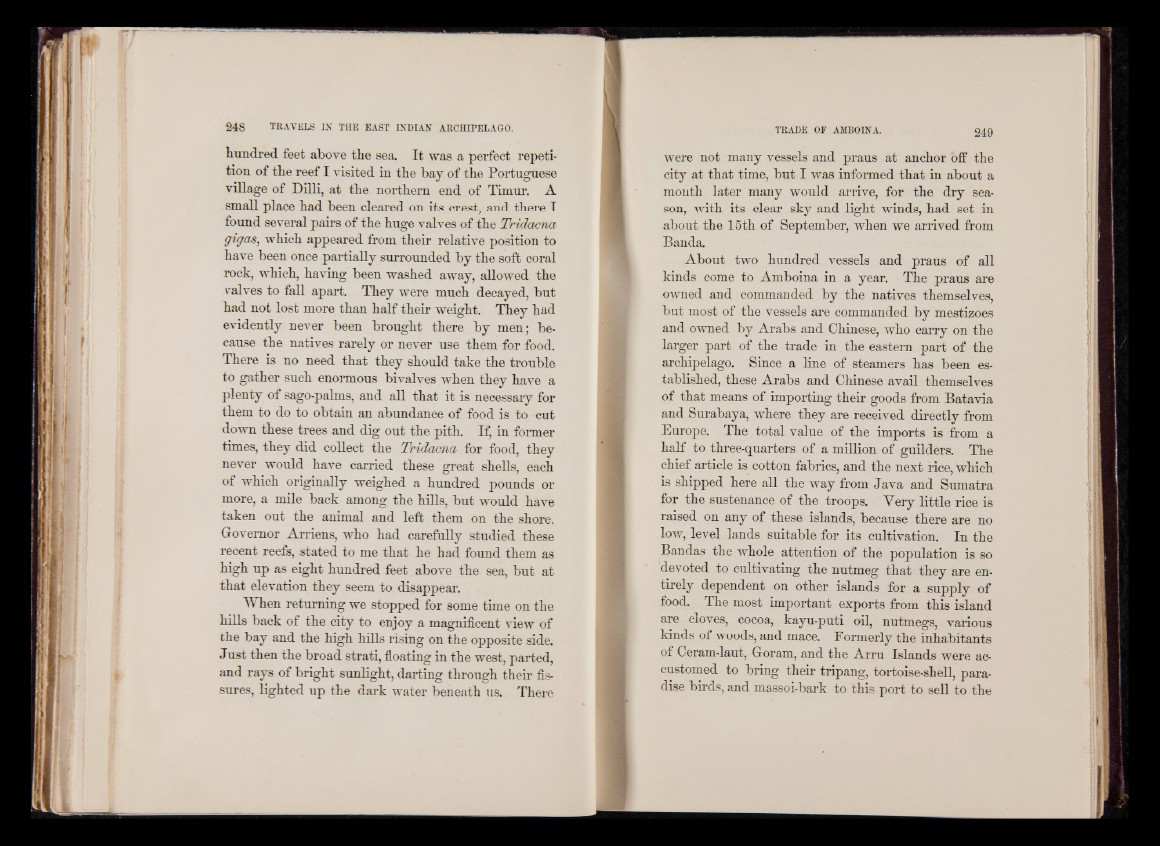
hundred feet above the sea. It was a perfect repetition
of the reef I visited in the bay of the Portuguese
village of Dilli, at the northern end of Timur. A
small place had been cleared on its crest, and there I
found several pairs of the huge valves of the Tridacna
gigas, which appeared from their relative position to
have been once partially surrounded by the soft coral
rock, which, having been washed away, allowed the
valves to fall apart. They were much decayed, but
had not lost more than half their weight. They had
evidently never been brought there by men; because
the natives rarely or never use them for food.
There is no need that they should take the trouble
to gather such enormous bivalves when they have a
plenty of sago-palms, and all that it is necessary for
them to do to obtain an abundance of food is to cut
down these trees and dig out the pith. If, in former
times, they did collect the Tridaoia for food, they
never would have carried these great shells, each
of which originally weighed a hundred pounds or
more, a mile back among the hills, but would have
taken out the animal and left them on the shore.
Governor Arriens, who had carefully studied these
recent reefs, stated to me that he had found them as
high up as eight hundred feet above the sea, but at
that elevation they seem to disappear.
When returning we stopped for some time on the
hills back of the city to enjoy a magnificent view of
the bay and the high hills rising on the opposite side.
Just then the broad strati, floating in the west, parted,
and rays of bright sunkght, darting through their fissures,
lighted up the dark water beneath us. There
were not many vessels and praus at anchor off the
city at that time, but I was informed that in about a
month later many would arrive, for the dry sea
son, with its clear sky and light winds, had set in
about the 15th of September, when we arrived from
Banda
About two hundred vessels and praus of all
kinds come to Amboina in a year. The praus are
owned and commanded by the natives themselves,
but most of the vessels are commanded by mestizoes
and owned by Arabs and Chinese, who carry on the
larger part of the trade in the eastern part of the
archipelago. Since a line of steamers has been established,
these Arabs and Chinese avail themselves
of that means of importing their goods from Batavia
and Surabaya, where they are received directly from
Europe. The total value of the imports is from a
half to three-quarters of a million of guilders. The
chief article is cotton fabrics, and the next rice, which
is shipped here all the way from Java and Sumatra
for the sustenance of the troops. Very little rice is
raised on any of these islands, because there are no
low, level lands suitable for its cultivation. In the
Bandas the whole attention of the population is so
devoted to cultivating the nutmeg that they are entirely
dependent on other islands for a supply of
food. The most important exports from this island
are cloves, cocoa, kayu-puti oil, nutmegs, various
kinds of woods, and mace. Formerly the inhabitants
of Ceram-laut, Goram, and the Arru Islands were accustomed
to bring their tripang, tortoise-shell, paradise
birds, and massoi-bark to this port to sell to the